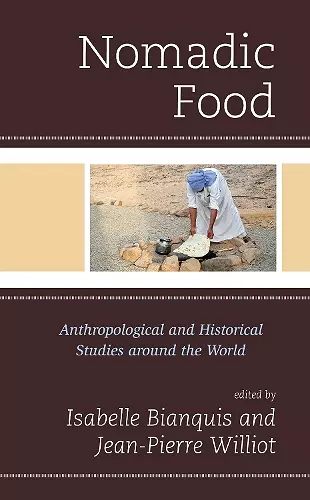Nomadic Food
Anthropological and Historical Studies around the World
Jean-Pierre Williot editor Isabelle Bianquis editor
Format:Hardback
Publisher:Bloomsbury Publishing PLC
Published:10th Oct '19
Currently unavailable, and unfortunately no date known when it will be back
This hardback is available in another edition too:
- Paperback£30.00was £30.00(9781538159644)

In this book, contributors examine the many meanings of the term 'nomad' through the study of food habits. Food and beverage products have become just as nomadic as other objects, such as telephones and computers, whereas in the past only food and money were able to move about with their carriers. Food industries have seized control of this trend to make it the characteristic feature of consumption outside the home - always faster and more convenient, the just-in-time meal: 'what I want, when I want, where I want', snacks, finger food, and street food. The terms reveal the contemporary modernity and spread of food practices, but they are only modified versions of older and more uncommon forms of behavior. Mobility, in the sense of multiple forms of moving about using public or individual, and possibly intermodal, means of transport, on spatial scales and temporal rhythms which are frequent and recurring but variable, responding to professional or leisure needs, can serve as a basic premise in order to gain insight into the concept of food nomadism.
This eclectic collection of essays treats nomadism and mobile populations around the globe, ranging across Senegal, Italy, Mongolia, Israel, Australia, Corsica, and Russian Siberia; one chapter even explores the ways NASA missions functioned as laboratories for nutrition in long-range space exploration. Thematically and topically interesting, the chapters link specific nomadic practices to food cultures within the context of globalization and late modernity. This collection takes a very wide view of what can be counted as nomadism: transnational, tourist, and migratory mobility are all covered under the same umbrella term. . . this has the advantage of pointing out certain similarities between different forms as they exist, have existed, or can be imagined to exist. . . these chapters will likely be useful in anthropology, migration, food studies, and food security courses; in classes covering specific populations and/or geographic areas; and those covering the forms of mobility mentioned above. Summing Up: Recommended. Lower-division undergraduates through graduate students; professionals. * Choice Reviews *
By smartly juxtaposing the gustatory practices of Bedouins, pilgrims, tourist and astronauts this Nomadic Food: Anthropological and Historical Studies around the World forces us to rethink the relationship between material culture and mobility, ecology and anthropology, biology and culture, to productively re-theorize nomadic eating. -- Krishnendu Ray, Chair of the Department of Nutrition and Food Studies, New York University, author of "The Ethnic Restaurateur" (2016)
What a rich and fascinating offering! This unique volume provides engaging and insightful perspectives on an important, yet uncommonly studied foodway. It shines light on places and cultures that are too often left out of food studies scholarship. -- Stephen Wooten, PhD, Associate Professor, Global Studies, Director, Food Studies Program, University of Oregon
ISBN: 9781538115985
Dimensions: 206mm x 161mm x 20mm
Weight: 553g
224 pages